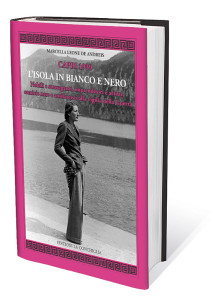 Marcella Leone De Andreis
Marcella Leone De Andreis
Capri 1939. L’isola in bianco e nero
Nobili e stravaganti, imprenditori e artisti, camicie nere e antifascisti alla vigilia della Guerra
Edizioni La Conchiglia – 35 €
Il libro racconta un periodo storico particolare. Il 1939 fu infatti l’ultimo anno di pace prima dello scoppio della seconda guerra mondiale, un avvenimento che causò un abbandono in tutta fretta dell’isola da parte della grande mondanità internazionale che nei venti anni precedenti aveva fatto di Capri una meta irrinunciabile. Anche se l’Italia entrò solo dieci mesi più tardi nel conflitto, già a quel tempo l’aria di cambiamento era presente.
Il duce l’aveva visitata nel 1924 e volle contribuire alla trasformazione dell’isola, a suo dire arretrata e ancora sconosciuta al pubblico italiano, in un luogo da sogno. Lo fece affidando il compito al barone Alberto Fassini, finanziere e uomo d’affari, sovvenzionatore del partito fascista che ci riuscì costruendo alberghi di alto livello, strade, fognature, illuminazione elettrica e soprattutto il porto. Da allora Capri vide approdare insieme al nutrito pubblico di stranieri, anche personalità di spicco dell’Italia del tempo. Umberto di Savoia con la moglie Maria Josè e sua sorella Mafalda, Filippo Tommaso Marinetti e Curzio Malaparte, Alberto Moravia ed Elsa Morante, solo per citarne alcuni. Tra gerarchi e non solo, ci furono anche molti antifascisti che approdarono sull’isola, ma anche Edda e Galeazzo Ciano, insieme ai loro figli, si innamorarono delle sue bellezze.
Su tutto e tutti spicca Capri, palcoscenico sempre ambito per vecchi e nuovi personaggi.
This book tells the story of a very particular historical period. 1939 was, in fact, the last year of peace before the Second World War broke out, an event that led to the hasty abandonment of the island by most of the international jet set that had made Capri an essential destination during the previous twenty years. Although Italy only entered the war ten months later, change was already in the air during that time.
Il Duce visited Capri in 1924 and wanted to contribute to the transformation of Capri, which he said was backward and still unknown to the Italian public, into a place of dreams. He entrusted the task to Baron Alberto Fassini, a financier and businessman who was a financial supporter of the fascist party, and he fulfilled the task by constructing high end hotels, street sewers, electric street lighting and above all the port. After that Capri was visited not only by substantial numbers of foreign tourists, but also by well-known personalities from the Italy of the time: Umberto of Savoy with his wife Maria Josè and his sister Mafalda, Filippo Tommaso Marinetti and Curzio Malaparte, Alberto Moravia and Elsa Morante, to mention only a few. Along with fascist party leaders and others, there were also many antifascists who came to the island; and then there were people such as Edda and Galeazzo Ciano, together with their children, who fell in love with the beauties of Capri.
Rising above everything and everyone stands Capri, always a sought-after stage for celebrities, old and new.
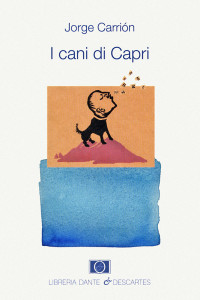 Jorge Carrión
Jorge Carrión
I cani di Capri
Libreria Dante & Descartes – 6 €
Tre brevi racconti e un fil rouge che li unisce, Curzio Malaparte. Un amante dei cani con i quali ha sempre vissuto e che come loro spesso “abbaiava”. Ma anche un uomo solo con i suoi cani e solo come un cane, come lo descrive l’autore. Parlare della sua casa è il pretesto per raccontare la sua personalità complessa e poliedrica. E seguendo le sue orme è impossibile non incontrare sull’isola di Capri tanti altri scrittori e artisti che l’hanno eletta come dimora, alla ricerca delle case che li hanno ospitati e dei luoghi che hanno rapito i loro cuori. “Casa come me”, il Vesuvio e il mare che circonda l’isola rappresentano dei simboli, ma anche un’occasione per raccontare la Capri di oggi. Tra questi luoghi non manca mai un cane che gironzola, sia esso il ricordo dei cani di Malaparte o il fedele amico di nuovi amanti dell’isola.
Three short stories linked by a common thread: Curzio Malaparte. He was a dog lover, who had always lived with dogs and would often “bark” like them, but he was also a man who lived by himself with his dogs, a loner, as the author describes. Talking about his house offers an opportunity to describe his complex, multi-faceted personality. And following in his footsteps, it is impossible not to come across many other writers and artists who chose the island of Capri as their home, searching out the houses where they stayed and the places that stole their hearts. “Casa come me”, Vesuvius and the sea surrounding the island represent symbols, but also offer an opportunity to talk about the Capri of today. And there is always a dog wandering around these places, whether it is the memory of Malaparte’s dogs or the faithful friend of new lovers of the island.
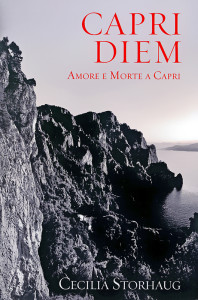 Cecilia Storhaug
Cecilia Storhaug
Capri Diem. Amore e morte a Capri
capridiem.net – 15 € | ebook 2,99 €
Un romanzo ispirato dall’affetto dell’autrice per Capri e per i suoi abitanti, un libro che parla d’amore, ma anche di morte. Quello di Cecilia Storhaug, autrice norvegese che vive tra il suo paese d’origine, la California e Capri, è un noir la cui storia si snoda tra le bellezze dell’isola. È infatti tra scorci spettacolari, luoghi di importanza storica e quelli più glamour che muove i suoi passi il protagonista alla ricerca di giustizia, redenzione e amore. Ad arricchire il volume alcuni disegni di Ugo Di Martino, artista caprese di ispirazione surrealista, uno per ognuno dei 67 capitoli in cui si intrecciano amore, vita quotidiana, azione e suspense. Il libro è disponibile nelle versioni italiana, inglese e Kindle.
A novel inspired by the author’s affection for Capri and its inhabitants, a book that speaks of love but also of death. This book by Cecilia Storhaug, the Norwegian author who divides her time between her home country, California and Capri, is a noir with a plot that is set amid the island’s beauty spots. The actions of the main character take place against the backdrop of spectacular views, places of historical importance and more glamorous sites, in search of justice, redemption and love. The book is illustrated with drawings by Ugo Di Martino, a Capri artist of Surrealist inspiration, with one for each of the 67 chapters in which love, daily life, action and suspense are all intertwined. The book is available in Italian and English versions, and on Kindle.
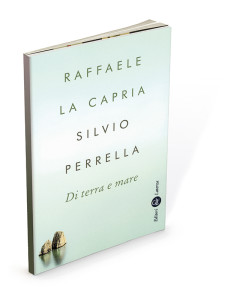 Raffaele La Capria e Silvio Perrella
Raffaele La Capria e Silvio Perrella
Di terra e mare
Editori Laterza – 14 €
Un libro scritto con la voce. Quella di Raffaele La Capria che si racconta a Silvio Perrella. Da questo incontro, da queste parole scaturisce uno scritto che è insieme presente e memoria. I ricordi di una vita emergono a poco a poco trasformandosi in parole.
L’occasione per ritrovarsi è unica perché la narrazione ha inizio nel giorno del novantacinquesimo compleanno di Dudù. Al centro di ogni ricordo il mare, a cominciare dal racconto di quando, tornando dall’America su un transatlantico, La Capria passò lo stretto di Gibilterra e comprese: «Cosa fosse il Mediterraneo io non sapevo, perché essendoci nato dentro, credevo che ogni mare fosse più o meno come questo […]». Un mare dove per La Capria già i nomi che lo contraddistinguono sono pieni di poesia e che hanno il sapore di casa. Un mare che visto dalla terra si fa apprezzare per i suoi colori, sfumature e riflessi. E che visto nel suo profondo, con gli occhi del sub che fu, regala sempre fortissime emozioni.
Ma il libro è soprattutto l’occasione per due amici di incontrarsi, ritrovarsi, parlare e ricordare l’amore, il desiderio, la vita. Due amici uniti da un’affinità elettiva e dal cui dialogo scaturisce un racconto a tratti malinconico ma spesso anche ironico. Ne emerge la figura di un uomo in grado di scrivere, anche solo attraverso la voce, pagine di vita vissuta e di sentimenti sempre autentici.
This is a book with a voice. The voice of Raffaele La Capria who tells his story to Silvio Perrella. From this meeting and these words springs a tale that is both present and a memoir. The memories of a life gradually emerge, transforming themselves into words. It was a unique opportunity to meet, as the story starts on Dudù’s 95th birthday.
At the centre of every memory is the sea, starting with the story of when, on his return from America on a transatlantic liner, La Capria passed the straits of Gibraltar and realised that: “I didn’t know what the Mediterranean was like, because having been born in it, I believed that every sea was more or less like this one […].” A sea where the names that are given to it are, for La Capria, themselves full of poetry and have the flavour of home. A sea that you admire from the land for its colours, nuances and reflections. And that when you penetrate its depths, with the eyes of the scuba diver that La Capria used to be, always arouses the most powerful of emotions.
But the book is above all the opportunity for two friends to get together again, to meet each other, talk, and remember love, desire and life. Two friends joined by an elective affinity and whose conversation produces a story that is in parts melancholic, but often humorous too. Emerging from it is the figure of a man able to write, even through the voice alone, pages of a life that has been lived and feelings that are still authentic.
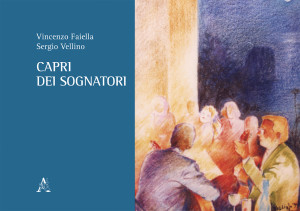 Vincenzo Faiella e Sergio Vellino
Vincenzo Faiella e Sergio Vellino
Capri dei sognatori
Aracne Editrice – 140 €
Con uno stile semplice, ma con tutta la forza e lo spessore di una grande ricerca scientifica alle spalle, Vincenzo Faiella e Sergio Vellino sono riusciti a racchiudere in un volume la summa del sapere musicale caprese. Il libro è una raccolta di artisti del presente e del passato, presentata in ordine alfabetico, che hanno cantato, scritto, musicato e reso celebri le canzoni napoletane, quelle con Capri protagonista in particolar modo. Gli autori, accomunati dalla passione per la musica e dall’amore per l’isola azzurra che ha dato a entrambi i natali, hanno scritto questo libro con l’intento di far sognare ancora una volta il pubblico con canzoni e musiche nostalgiche e antiche, ma senza il ricordo delle quali oggi Capri non sarebbe quella che è.
In a simple style, but with all the power and insight of extensive academic research behind them, Vincenzo Faiella and Sergio Vellino have managed to encapsulate in one volume the summation of Capri musical knowledge. The book is a collection of artists from the present and past, presented in alphabetical order, who have sung, written, set to music and made famous the Neapolitan songs, particularly those featuring Capri. The authors, who share a passion for music and a love for the azure isle where both of them were born, have written this book with the intention of making their audience dream again through the old, nostalgic songs and music, without whose memory Capri would not be what it is today.
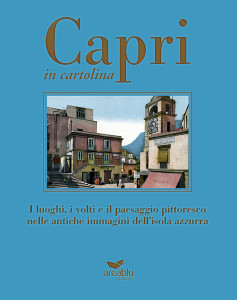 Mariano Della Corte, Agnello Baldi e Gianmaria Lembo
Mariano Della Corte, Agnello Baldi e Gianmaria Lembo
A cura di Alfonso Prisco
Capri in cartolina
I luoghi, i volti e il paesaggio pittoresco nelle antiche immagini dell’isola azzurra
Edizioni Area Blu – 50 €
Sembrano un ricordo lontano, eppure le cartoline richiamano ancora alla mente pensieri romantici e senza tempo. Sentimenti che rivivono nelle pagine del volume che raccoglie circa 500 immagini con Capri protagonista.
Questa raccolta rappresenta una splendida opportunità per conoscere l’evoluzione del paesaggio e dei costumi capresi. Ma è anche un’occasione per immergersi nella storia dell’isola vista attraverso le cartoline postali, comparse alla fine dell’dell’Ottocento. Ed è proprio da lì che inizia il racconto, fino ad arrivare agli anni Sessanta del secolo XX. Nove centimetri per quattordici, di solito, in cui riportare illustrazioni e dipinti prima, fotografie poi. Il Grand Tour diede alle cartoline capresi un primo impulso, la bellezza dell’isola poi fece il resto.
They seem a distant memory, but postcards still bring to mind romantic, timeless thoughts. Feelings that live again through the pages of this book that collects together 500 images featuring Capri.
This collection offers a splendid opportunity to find out about the evolution of the Capri landscape and customs. But it is also a chance to become immersed in the history of the island seen through the postcards, which started appearing at the end of the 19th century. And that is where the story begins, continuing up until the 1960s. Nine centimetres by fourteen, usually, with illustrations and paintings at first, followed by photographs. The Grand Tour supplied the first impetus to the Capri postcards, and the beauty of the island did the rest.





